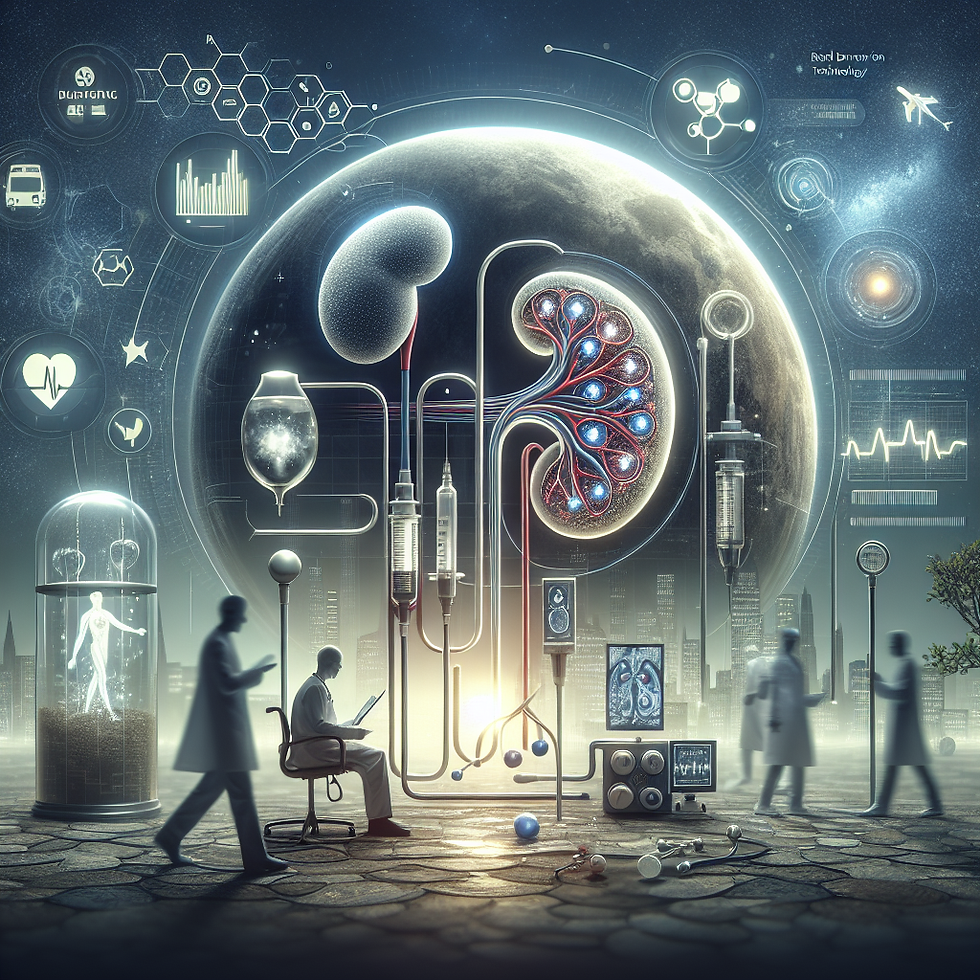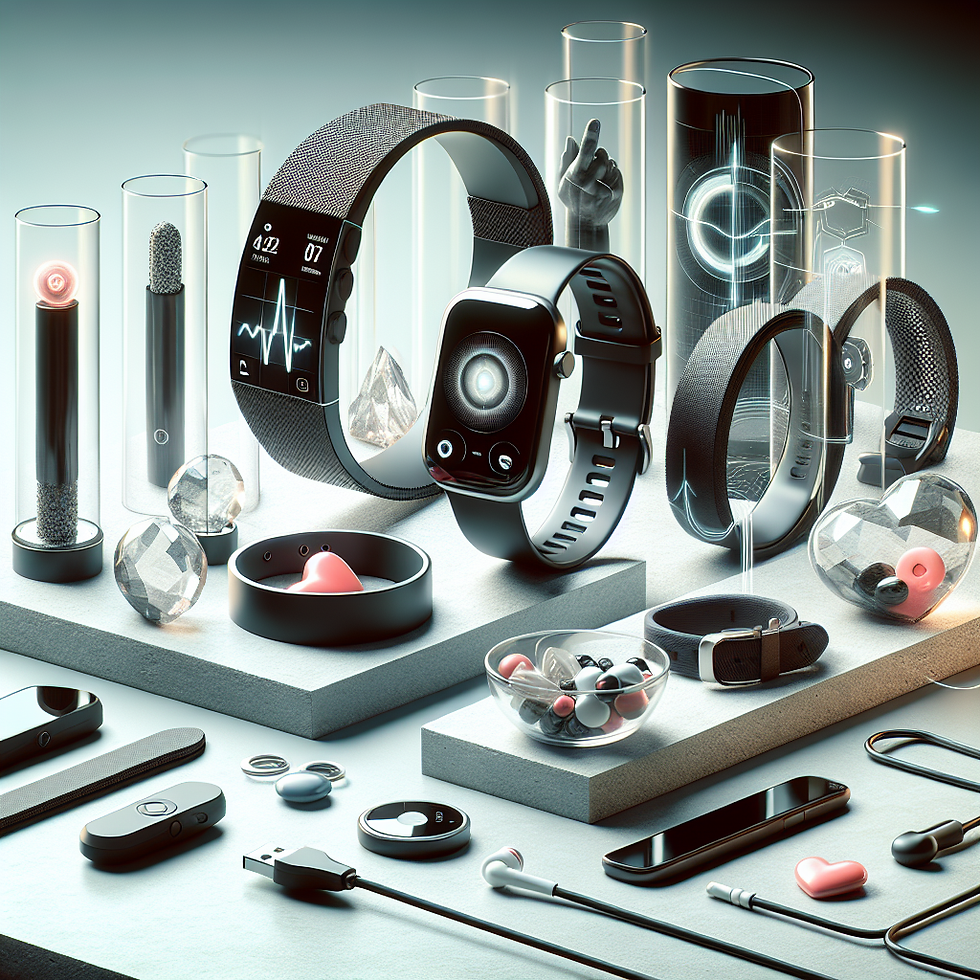Revolutionizing Electrophysiology: The Future Unfolds with Augmented Reality and AI-Driven Precision
- Michael Browers
- Apr 15, 2024
- 7 min read

The field of electrophysiology continues to trek forward on the back of groundbreaking transformation, propelled by cutting-edge technologies that promise to revolutionize cardiac ablation procedures. As we peer into the future, two powerful forces stand at the forefront of this metamorphosis - Augmented Reality (AR) and AI-Driven Precision Ablation. These innovative advancements are poised to reshape medical education, procedural accuracy, and patient outcomes in electrophysiology.
In the realm of enhanced electrophysiology procedures, Virtual Reality (VR) and Augmented Reality (AR) simulations are potential game-changers. By replicating the intricacies of cardiac ablation procedures in lifelike virtual environments, simulations can empower physicians with unmatched procedural familiarity and skill development. Sophisticated haptic feedback systems and visual overlays promise to enable clinicians to navigate through anatomical variations and dynamic tissue interactions, fostering higher levels of confidence and competence.
Sentiar's pioneering Command EP solution stands as a testament to the potential of AR in the medical environment. Leveraging real-time data from catheters and 3D electroanatomic mapping systems, Command EP offers interactive, 3D guidance during cardiac ablation procedures, to significantly improve localization accuracy within the heart and streamline communication within the operating room.
In tandem with AR, Advancing Computing and AI-Driven Strategies are primed to drive precision within ablation procedures to new heights. Volta Medical's AF-Xplorer™ is at the forefront of this transformative trend, harnessing the immense power of sophisticated computing systems and AI-driven algorithms. By analyzing vast datasets of EGMs, AF-Xplorer™ empowers electrophysiologists with targeted analysis to develop standardized treatment approaches.
This article delves into the promise of these technologies, their current achievements, and the potential they hold in shaping the future of electrophysiology. As AR and AI-Driven Precision Ablation mature and further embed into the catheter ablation and mapping technology landscape, the competitive landscape of the electrophysiology market will undoubtedly see profound shifts. Healthcare institutions and physicians will be presented with new possibilities, enabling them to provide improved treatment outcomes and elevate the standard of cardiac care. Let us explore the remarkable developments that await us in the realm of electrophysiology, where innovation merges with medicine to create a brighter future for patients and practitioners alike.
Enhancing Electrophysiology Procedures with Augmented Reality
Virtual reality (VR) and augmented reality (AR) simulations are at the forefront of early-stage development in the field of electrophysiology. These advanced technologies aim to revolutionize training and visualization for physicians performing cardiac ablation procedures. Through sophisticated feedback systems and visual overlays, these simulations replicate the complexities of such procedures, including anatomical variations and dynamic tissue interactions. As physicians immerse themselves in lifelike virtual environments, the goal is to enable physicians to feel and respond to virtual tissue responses in real time, fostering enhanced procedural familiarity and skill development.
The integration of VR and AR training into medical education holds significant potential for empowering electrophysiologists with higher levels of confidence and competency in performing cardiac ablation procedures. The immersive nature of these types of simulations aims to allow clinicians to practice repeatedly in a risk-free environment, enabling them to adapt to challenging scenarios and refine their techniques. As a result, physicians can acquire essential muscle memory, enhancing precision during actual patient procedures and leading to more proficient and assured medical practitioners.
In the realm of real-world technology development, Sentiar is making strides with its
Command EP solution. Command EP leverages augmented reality to guide physicians during cardiac ablation procedures with an interactive, real-time, 3D interface. By using real-time data from catheters and 3D electroanatomic mapping systems, Command EP recreates an anatomical and electrical map of the patient's heart, improving localization accuracy.
Moreover, Command EP streamlines communication within the operating room, reducing the number of commands physicians give to their attending colleagues. Tests indicate that Sentiar's technology minimizes the average number of commands per target point during a standard interventional procedure, resulting in smoother and more efficient operations.
Sentiar utilizes state-of-the-art XR hardware, specifically Microsoft's Hololens, as the delivery platform for their Command EP augmented reality software. While this technology might evoke the appeal of gaming, it is crucial to note that Sentiar's solution is purpose-built for medical applications and not intended as a mere video game. By drawing inspiration from immersive gaming experiences, Sentiar enhances the physical environment, maximizing engagement, and improving awareness during cardiac ablation procedures.
Sentiar's Command EP represents a pioneering step towards leveraging augmented reality in the medical environment, offering exciting prospects for optimizing electrophysiology procedures and ultimately benefiting patients with improved treatment outcomes.
Advancing Computing and AI-Driven Strategies for Precision Ablation Procedures
In the realm of early-stage development, Volta Medical is at the forefront of advancing computing and AI-driven strategies in the field of electrophysiology. Their innovative technology, AF-Xplorer™, represents a significant step forward in treatment planning and precision ablation procedures.
Harnessing the immense computational power of sophisticated computing systems, AF-Xplorer™ aims to revolutionize treatment planning through advanced algorithms. Rapid simulations within the system pave the way for standardized electrophysiology catheter strategies based on robust data-driven analysis. By leveraging these cutting-edge capabilities, treatment planning becomes more efficient and precise, leading to more effective and targeted cardiac ablation procedures.
One of the key aspects of Volta Medical's breakthrough technology is the integration of a carefully crafted workflow that integrates and overlays with most EP recording and 3D mapping systems for an intuitive and fast learning curve. Through AI-driven precision, AF-Xplorer™ plays a pivotal role in targeting therapy through the automatic detection of dispersed electrograms consistent with sources of arrhythmias within the heart. Volta Medical's AF-Xplorer™ exemplifies the trend of aligning procedures to rapid, AI-aided identification of relevant patient characteristics and arrhythmia profiles. As an aid to the electrophysiologist, optimized outcomes and improved patient experiences, underscore the commitment to patient-centric care and better treatment results. Specifically designed for the assessment of complex atrial fibrillation (AF) and atrial tachycardia (AT) during ablation procedures, AF-Xplorer™ serves as a prime example of how AI and data-driven technologies are driving advancements in the field.
Through its rapid analysis capabilities, AF-Xplorer™ guides real-time decision-making with machine learning algorithms, including deep learning. The algorithms have been trained on a vast database of electrograms (EGMs), meticulously annotated by expert electrophysiologists. This wealth of data-driven insights equip medical professionals with invaluable guidance, bringing the acute and long-term outcomes of expert electrophysiologists right into the EP lab.
As Volta Medical's AF-Xplorer™ continues to advance, it holds the potential to transform the landscape of electrophysiology procedures, offering precision, efficiency, and improved patient outcomes in the realm of cardiac ablation treatments.
Next-Generation Precision for Ablation Technologies: Advancements Shaping the Future of Cardiac Procedures
In the rapidly evolving landscape of cardiac ablation, mapping, and navigation technologies, next-generation precision is a driving force behind advancements in treatment strategies. Continued advancements in mapping and navigation systems, as well as radiofrequency (RF) and cryoablation technologies along with anticipated first-wave pulsed field ablation (PFA) technologies that are expected to enter the market in 2024 and beyond, continue to revolutionize the field of electrophysiology.
Enhanced Lesion Control: Innovators of ablation technologies are exploring advanced technologies to achieve precise and customizable lesion formation. This entails refining energy delivery algorithms to target specific tissue areas accurately. By optimizing energy delivery, these technologies aim to create well-defined and predictable lesions, ultimately enhancing treatment efficacy and improving patient outcomes while reducing the risk of complications.
Real-Time Lesion Assessment: A pivotal aspect of future-generation precision is likely to be real-time lesion assessment. Academic research suggests that incorporating advanced imaging modalities, such as intracardiac echocardiography (ICE) via a near-field ultrasound (NFUS) transducer in the tip of the catheter might help visualize the myocardium to provide an image of the developing lesion formation during energy delivery during procedures. Immediate feedback would enable clinicians to adjust energy delivery parameters in real time, ensuring optimal lesion formation and procedural success.
Closed-Loop Feedback Systems Integration: Continuous monitoring and adjustment of energy delivery parameters in real time are made possible by integrating closed-loop feedback systems. Utilizing data from temperature sensors or impedance measurements, these systems assess the effectiveness of energy delivery and lesion formation. By constantly adapting energy settings based on real-time data, closed-loop systems optimize treatment efficacy, contributing to enhanced procedural safety and success rates.
Precision Mapping and Navigation: As new 3D mapping and navigation systems are developed and launched, increasingly detailed and accurate anatomical maps of the heart empower electrophysiologists with precise catheter positioning and lesion targeting capabilities. Improved navigation tools and visualization interfaces facilitate planning and executing procedures with unparalleled accuracy and confidence.
The convergence of contemporary commercialized RF and cryoablation technologies, alongside the anticipation of first-wave PFA technologies entering the market, heralds an era of unprecedented precision in cardiac ablation procedures. The ongoing advancements in energy delivery algorithms, real-time lesion assessment, closed-loop feedback systems, and precision mapping and navigation are poised to revolutionize the practice of electrophysiology. As these technologies continue to mature, the future of ablation procedures holds promise for improved precision, patient outcomes, and overall advancements in cardiac care.
In conclusion, the future of electrophysiology is on an early and exciting journey toward the convergence of augmented reality, AI-driven precision, and sophisticated computing systems. These transformative trends extend beyond traditional energy delivery and catheter design, venturing into computer-driven visualization and intelligence. By empowering electrophysiologists to plan and deliver optimal treatments informed by vast and diverse datasets, as well as therapy optimized to each patient's unique anatomy and pathology, these technologies have the potential to redefine the landscape of cardiac ablation procedures.
The incubation of much of this innovation within the start-up space allows for rapid iteration and refinement of winning solutions. As successful technologies are identified and integrated into the commercial landscape, likely through mergers and acquisitions, the established medical device OEMs will embrace a new wave of innovation and technology. With the potential for share shifts, new growth opportunities are poised to infuse excitement into a market already characterized by a strong growth profile. The marriage of cutting-edge technologies with electrophysiology will continue a legacy marked by a focus on enhanced procedural efficacy, improved patient outcomes, and a brighter future for cardiac care. As these advancements unfold, the horizon for electrophysiology holds the promise of a transformation driven by innovation and propelled by technology's boundless possibilities.
For more information on the innovative companies, technologies, and academic research, check out the following links:




Comments